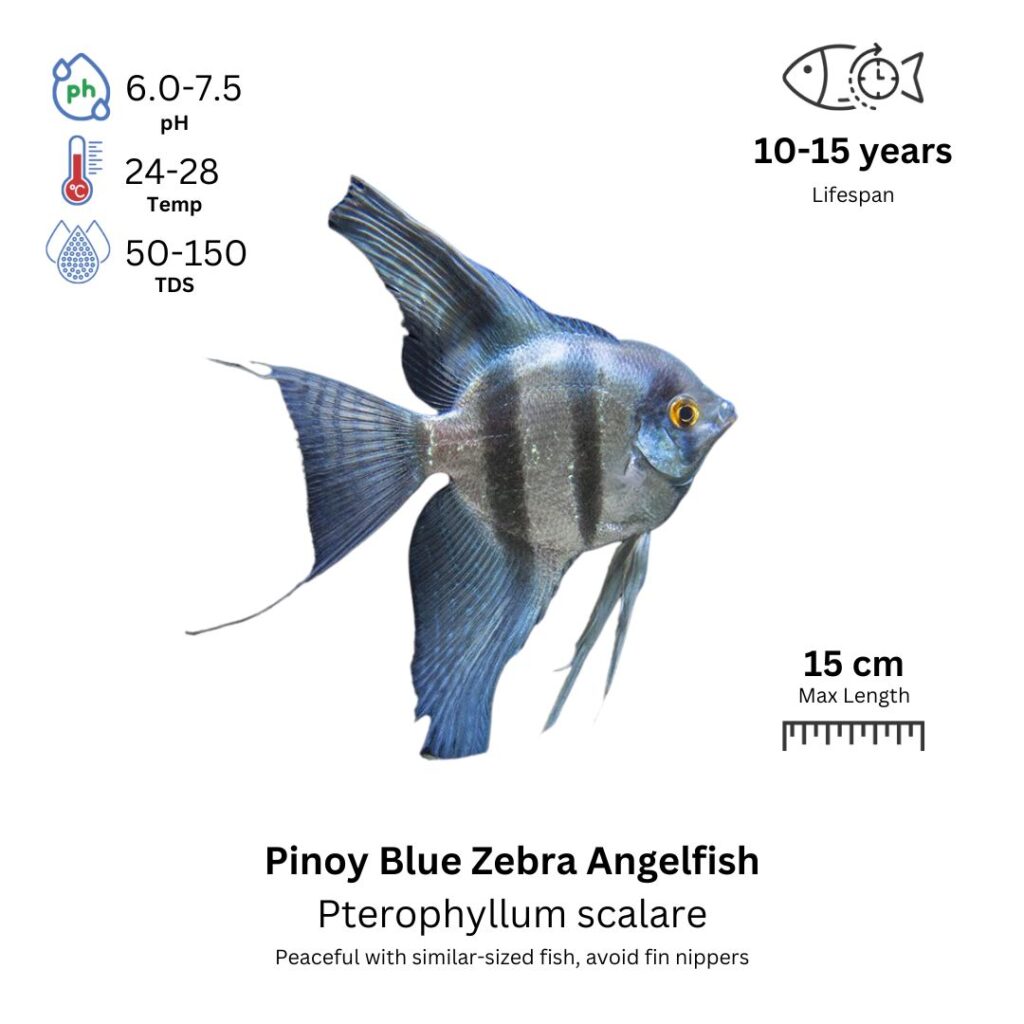Pinoy Blue Zebra Angelfish
Pterophyllum scalare

Description
The Pinoy Blue Zebra Angelfish is a striking variety of the popular freshwater angelfish, Pterophyllum scalare. This variety is known for its beautiful blue coloration with zebra-like stripes, which give it a unique and mesmerizing appearance. The body is typically light to medium blue with darker vertical stripes running along the fish’s body. These stripes give it the characteristic “zebra” look, and they are more pronounced in males, especially during breeding seasons. The fins of the Pinoy Blue Zebra Angelfish are long and flowing, adding to the grace and beauty of the fish.
Habitat Origin
The Pinoy Blue Zebra Angelfish is a selectively bred variety of the wild angelfish (Pterophyllum scalare), which is native to the Amazon Basin in South America. In the wild, angelfish are found in slow-moving rivers, streams, and flooded areas with abundant vegetation. They prefer warm, slightly acidic to neutral water and thrive in environments that offer hiding spots such as plants, rocks, and driftwood.
Aquarium
Ideal Number in Aquarium: At least 2-3 individuals, as angelfish are social and feel more comfortable in groups. However, a single pair is ideal if you want to avoid territorial disputes among males.
Favorite Food

Pinoy Blue Zebra Angelfish are omnivores and will accept a variety of foods. They can be fed high-quality flake food, pellets, and live or frozen foods such as brine shrimp, bloodworms, daphnia, and grindal worms. They also benefit from vegetable-based foods, such as spirulina, blanched zucchini, and lettuce. A well-rounded diet is essential for maintaining their health and vibrant coloration.
Behavior:
The Pinoy Blue Zebra Angelfish is generally peaceful but may show some territorial behavior, particularly when breeding or defending its space. They are graceful swimmers, often seen gliding in the middle or upper levels of the tank. While they are not overly aggressive, males can become more territorial during mating and will display their colorful fins to attract females. They are typically calm around other peaceful fish, but they may chase away smaller fish or other angelfish, especially if they feel their space is threatened.
Special Care:
Pinoy Blue Zebra Angelfish require stable water conditions, so regular water changes and good filtration are essential. While they are relatively hardy, they are sensitive to poor water quality, especially ammonia and nitrate levels. To replicate their natural environment, provide plenty of plants, decorations, and hiding spots for the fish. A soft, fine substrate such as sand or smooth gravel is ideal for these fish, as they often like to sift through the substrate for food.
Compatibility with Other Fish:
Pinoy Blue Zebra Angelfish are compatible with a variety of peaceful species. They can live with other peaceful community fish such as tetras, rasboras, small catfish, and gouramis. However, they should not be kept with aggressive species or small fish that might be stressed or eaten. It is best to avoid housing them with other angelfish unless there is sufficient space for each fish to establish its territory.
Breeding Setup
A separate breeding tank is highly recommended for Pinoy Blue Zebra Angelfish due to their territorial behavior during breeding. A tank size of 100–150 liters (25–40 gallons) is ideal, providing ample swimming room and allowing the pair to establish territories. Maintain water parameters with a pH of 6.5–7.5, temperature between 26–30°C, and hardness around 6–12 dGH. Use a sponge filter or low-flow internal filter to ensure good water quality without creating strong currents that might disturb the eggs or fry. For substrate, fine gravel or sand works best, and add broad-leafed plants like Amazon Sword or Java Fern, as angelfish often lay eggs on vertical surfaces. Moderate lighting with some shaded areas or floating plants helps reduce stress.
Conditioning for Breeding
Before breeding, condition the angelfish with a nutritious, high-protein diet. Feed them a variety of foods such as brine shrimp, bloodworms, daphnia, and supplement with quality cichlid flakes or pellets. This helps the female produce healthy eggs and stimulates the male’s courtship behavior. Regular partial water changes (20–30%) are essential to maintain water quality and can mimic environmental cues for spawning. Slightly increasing the temperature to 28°C (82°F) can also encourage breeding behavior.
Spawning Process
Spawning typically occurs once the pair is well-conditioned and the water parameters are optimal. The male displays brighter colors and initiates courtship by chasing the female. The female will lay 100–500 small yellowish eggs in rows on a vertical surface, such as aquarium glass or a plant leaf. The male follows closely to fertilize them. After laying, both parents should remain in the tank, as they will take turns fanning the eggs and guarding them against potential threats. The pair often shows strong parental instincts and will continue this care until the eggs hatch.
Fry Development & Care
The eggs hatch within 2–4 days, depending on water temperature. Once the fry absorb their yolk sacs—typically by day 3—they begin to swim freely. At this stage, feed them infusoria or liquid fry food, followed by newly hatched brine shrimp or crushed flakes after a week. Perform small water changes (10–15%) every 2–3 days to keep the environment clean. Use a sponge filter to avoid sucking up the fry and maintain a stable temperature between 26–30°C. Providing plenty of plants and hiding spots helps reduce stress and supports healthy growth.
Breeding Tips
Pinoy Blue Zebra Angelfish typically reach sexual maturity around 6–12 months. Males are often more colorful with pointed dorsal fins, while females appear rounder, especially when carrying eggs. To reduce stress and promote successful breeding, avoid overcrowding, maintain stable water parameters, and remove any aggressive tankmates. Providing a calm, clean environment with consistent lighting and minimal disturbances will increase the chances of successful spawning and healthy fry development.
